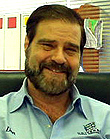|
|
This topic comprises 3 pages: 1 2 3
|
|
Author
|
Topic: Identifying Surround EX Prints
|
|
|
John Hawkinson
Film God

Posts: 2273
From: Cambridge, MA, USA
Registered: Feb 2002
|
 posted 04-12-2002 10:36 AM
posted 04-12-2002 10:36 AM




I thought I'd bump this up in response to the discussion in the Blade 2 topic over in "Feature Info & Trailer Attachments" (no "chit-chat," huh? where's Brad lurking...)Searching for "EX" over here is a bit of a pain, since you
get "excited" and "exhibitor" too. Two other threads of some
interest (though there's plenty more):
code:
surround EX 02-11-2000
EX? Sorry, not with this title... 06-09-2000
Anyhow, over in the Blade 2 topic, Chase Taylor commented that 5-digit DTS serial numbers represent EX, and Brad said something similar at some other time. Is it actually 5-digit serial numbers, or is it all serial numbers with the high-bit set (i.e. 32767-65535)? Is this actually encoded in the serial number, or is that just a convention, and is there actually another bit or code on the DTS discs that reports it for sure? Back on 09-15-2000 06:18 AM in (Sorry...), John Pytlak said
quote:
One positive way of identifying the sound encoding on every print would be to write the information in the analog soundtrack area of the sound negative leaders, so it is printed onto every print made from that negative. The responsibility would fall to the sound recording facility that makes the negative, who should certainly know what type of tracks are on the negative.
What ever happened with that? It seems like such a good idea... --jhawk
| IP: Logged
|
|
John Pytlak
Film God

Posts: 9987
From: Rochester, NY 14650-1922
Registered: Jan 2000
|
 posted 04-12-2002 12:41 PM
posted 04-12-2002 12:41 PM





SMPTE Recommended Practice RP 152 specifies "Edge Identification of Leader and Picture for 35-mm Release Prints". It says: "The identification shall include at least the title of the picture, the type of soundtrack, and the specific reel number. Inclusion of the projection aspect ratio is desirable".Standard SMPTE 301 "Theater Projection Leader, Trailer and Cue Marks" also specifies the locations in the leader for information about Length, Titles, Track, Lab, Company, Prod. No., Special Data, Aspect Ratio, Sound Type, and Frame Rate. As you may know, SMPTE Standards and Recommended Practices are voluntary. Affected users are the ones who need to "enforce" them -- this means YOU! Write the distributor, asking that this complete information always be included, and why it will help have "Film Done Right" in your theatre. ------------------
John P. Pytlak, Senior Technical Specialist
Worldwide Technical Services, Entertainment Imaging
Research Labs, Building 69, Room 7525A
Rochester, New York, 14650-1922 USA
Tel: +1 585 477 5325 Cell: +1 585 781 4036 Fax: +1 585 722 7243
E-Mail: john.pytlak@kodak.com
Web site: http://www.kodak.com/go/motion
| IP: Logged
|
|
John Hawkinson
Film God

Posts: 2273
From: Cambridge, MA, USA
Registered: Feb 2002
|
 posted 04-12-2002 03:11 PM
posted 04-12-2002 03:11 PM




Thanks, John; In your September 2000 post, you gave the impression that you were going to bring this up at SMPTE and Inter-Society meetings, in order to effect some change. It looks to me that the latest versions of the standards you cited are less recent than your post, viz. SMPTE RP152-1994 ($15) and SMPTE 301M-1999 ($24). So I'm left wondering if the conclusion of bringing it up at those meetings was, "this is already in the standards, all we can do is ask exhibitors to put pressure on distributors and labs to implement them." Or was there something else in mind? I'm all for drafting letters, but some effort should probably go into if we'd seriously like to effect change. Probably someone who has a copy of the aforementioned standards should draft such a thing, and include clear examples of what is and is not reasaonble. It also seems that this sort of thing is most effective when other people jump on the bandwagon. A single letter is much less persuasive than 100 letters, or perhaps a single letter signed by a large number of people. Are folks interested in this, and would participants be willing to lend their names and affiliation to such a communication? If so, would anyone with a copy of the aforementioned standards care to draft such a communication? If there's interest, it certainly won't break the bank for me to go buy the standards and draft something, though money is relatively tight around here.
A technical question -- what does "edge identification" refer to? Does that mean text in the soundtrack area, or does it actually refer to text outside the sprockets where edgecodes/keycodes are?
--jhawk
| IP: Logged
|
|
|
|
|
|
|
|
|
|
|
|
|
|
Bobby Henderson
"Ask me about Trajan."

Posts: 10973
From: Lawton, OK, USA
Registered: Apr 2001
|
 posted 04-12-2002 10:23 PM
posted 04-12-2002 10:23 PM




Don't rely on newspaper stack ads for telling whether a film has been mixed for the Surround EX format. I have seen a lot of New York Times and L.A. Times stack ads use the DD-EX logo on films that were definitely not mixed for EX. The theaters using the EX logo in the ad work must be turing the EX processor on for all shows (which of course is totally inappropriate).The only piece of advertising that seems dependable at all for identifying a Surround EX film is the movie poster one sheet itself. For instance, the "Star Wars: Episode II" poster has the DD-EX logo on it. The movie poster area of a stack ad may feature the DD-EX logo as well. The one sheets for films like "The World Is Not Enough" did not have the DD-EX logo, but the poster art in the newspaper ads did. I've only seen that with actual DD-EX films. Unfortunately, there is a larger number of films mixed for DD-EX that are never identified as being mixed for Surround EX. Joe brought up "Fight Club" as an example. I don't remember ever seeing the DD-EX logo on any "Gladiator" or "Mission Impossible 2" art. There's a lot of other films that fall into that category as well, with "Lord of the Rings: Fellowship of the Ring" being one of the most recent examples. To make matters even worse (well, at least for anyone keeping up with the films once they get into home release) is Dolby Labs does not allow the Dolby Digital Surround EX logo to be used on DVD packaging. They have also put a stop to allowing the logo to be emblazoned on home theater hardware as well. You may see "THX Surround EX" and "DTS-ES" logos all over the place, but the Dolby Digital Surround EX logo is strictly for commercial theater use only. That might be fine and all from a certain standpoint; however, most here would agree the identification of DD-EX theatrical releases has been very very poor overall. One other item, there are many many Quad Format SR/SRD/DTS/SDDS print releases every year. Very few of those feature Surround EX optimized mixes. Nearly every Surround EX release has been on a Quad Format print (with "The Art of War" being possibly the only exception; it was a SR/SRD only release). My own personal opinion is that Surround EX is largely a dud in how it has been marketed. There are very few theaters in my area equipped for Dolby Digital Surround EX or even DTS-ES for that matter. And I would bet that there is a small minority of theaters that actually uses the extended surround equipment properly (that being using it only for Surround EX mixed releases).
| IP: Logged
|
|
Brad Miller
Administrator

Posts: 17775
From: Plano, TX (36.2 miles NW of Rockwall)
Registered: May 99
|
 posted 04-13-2002 04:03 PM
posted 04-13-2002 04:03 PM




Actually Don, I'm going to jump in here and clarify your comment.So what happens if you play a non-EX encoded film in EX? That depends entirely on the film. Scenario #1 - You are playing a film in analog, or the film was mixed with mono surrounds. ALL of the sound in the surround channels will be directed to the rear and the sides will be dead. Scenario #2 - You are playing a non-EX film in digital, that does have split surrounds. This is where it gets tricky. Now assuming the sound mixers did not really utilize the "stereo" part of the surrounds much, most all of your sound will be directed into the rear channel and the sides will be dead. (A good example of this is "A Knight's Tale".) However... Scenario #3 - You are playing a non-EX film in digital, that does have split surrounds and the "stereo" surrounds were used routinely (as is *most* of today's film mixes). You will actually have a very pleasant EX effect. Now as to whether this was intended or not is a completely different story. However I throw the movie "Vertical Limit" out as a movie that I accidentally forgot to turn off the EX decoder when I screened it and WOW! Very impressive!!! In fact, I would go so far as to say this film sounded far better than any film actually mixed for EX. So really, it all depends.
| IP: Logged
|
|
|
|
Bobby Henderson
"Ask me about Trajan."

Posts: 10973
From: Lawton, OK, USA
Registered: Apr 2001
|
 posted 04-13-2002 07:51 PM
posted 04-13-2002 07:51 PM




Surround EX is just a Dolby Pro-Logic style approach applied to the surround channels. In stereo material for the home whenever volume levels for a sound event are identical in volume level between Left and Right channels that sound element gets directed to the center. Most films mixed for Dolby Stereo and Dolby Surround use this method to anchor dialog in the center channel.The same method is used in the surrounds. If volume levels reach the same level of intensity in Right Surround and Left Surround channels for a particular sound element, that element will be pulled back to the Center Surround channel and the sides will go dead as Brad described. Some films should never be played with Surround EX. That includes all analog Dolby Stereo and SR shows. You have only mono surround with those formats. Side walls will be dead and only the back wall will work. The effect is very distracting. The same thing will happen for people in DVD land when playing discs with 4.1 channel track like "The Abyss". My father did this with his new Denon 4802 receiver and thought something was wrong until I explained why the surrounds were locked to his back wall. My opinion is no movie should ever be played in Surround EX mode unless it was mixed specifically for the format. If not, it should play in straight 5.1 instead. Now, "Vertical Limit" might be an interesting exception. But at least Brad previewed the film and made sure it sounded good (and as it turned out, very good) before selling any tickets for the show with the system set for EX. I have a strong feeling many theaters equipped for Surround EX or DTS-ES are just leaving the systems turned on for all shows whether they were mixed for Surround EX or not.
| IP: Logged
|
|
|
|
|
|
All times are Central (GMT -6:00)
|
This topic comprises 3 pages: 1 2 3
|
Powered by Infopop Corporation
UBB.classicTM
6.3.1.2
The Film-Tech Forums are designed for various members related to the cinema industry to express their opinions, viewpoints and testimonials on various products, services and events based upon speculation, personal knowledge and factual information through use, therefore all views represented here allow no liability upon the publishers of this web site and the owners of said views assume no liability for any ill will resulting from these postings. The posts made here are for educational as well as entertainment purposes and as such anyone viewing this portion of the website must accept these views as statements of the author of that opinion
and agrees to release the authors from any and all liability.
|

 Home
Home
 Products
Products
 Store
Store
 Forum
Forum
 Warehouse
Warehouse
 Contact Us
Contact Us




 Printer-friendly view of this topic
Printer-friendly view of this topic

















